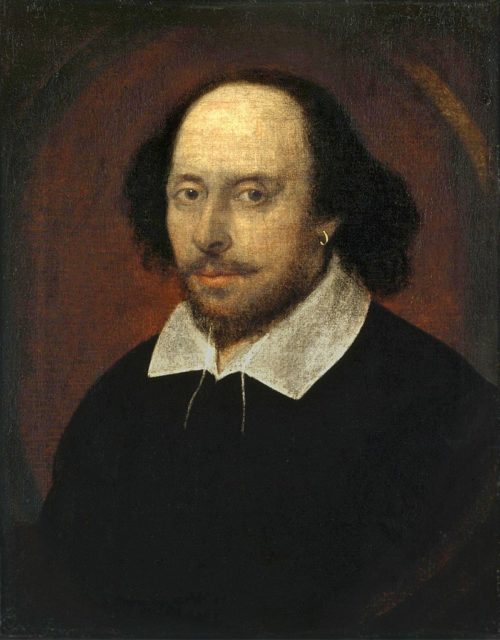Oliver Kamm discusses the most recent “Was Shakespeare really …?” article, this one published in The Atlantic by Elizabeth Winkler:

This was long thought to be the only portrait of William Shakespeare that had any claim to have been painted from life, until another possible life portrait, the Cobbe portrait, was revealed in 2009. The portrait is known as the “Chandos portrait” after a previous owner, James Brydges, 1st Duke of Chandos. It was the first portrait to be acquired by the National Portrait Gallery in 1856. The artist may be by a painter called John Taylor who was an important member of the Painter-Stainers’ Company.
National Portrait Gallery image via Wikimedia Commons.
[Winkler] accuses what she calls orthodox Shakespeare scholars of “a dogmatism of their own” on the issue, whereby “even to dabble in authorship questions is considered a sign of bad faith, a blinkered failure to countenance genius in a glover’s son.” Armed with this tendentious premise, along with the less contentious one that Shakespeare depicts female characters with unrivalled sympathy and insight, Winkler spins a hypothesis that Emilia Bassano, born in London in 1569 to Venetian immigrants, is a viable candidate for the true author.
Even as I read Winkler’s piece, I expected a denouement that it was all a piece of fiction, analogous to the enjoyable 2009 caper St Trinian’s 2: The Legend of Fritton’s Gold, which ends with buried treasure under the Globe Theatre and the discovery of Shakespeare’s true identity. It never came. The article was presented as a serious contribution to a debate in which Winkler has made a potentially historic discovery.
In British newspapers, there is a longstanding technique of obscuring a paucity of evidence in support of a preposterous thesis by posing it as a question. It’s been dubbed by the political commentator John Rentoul “Questions to Which the Answer is No” (QTWAIN). Winkler’s article employs the stratagem liberally. “Was Shakespeare’s name useful camouflage, allowing [Bassano] to publish what she otherwise couldn’t?” “Could Bassano have contributed [to literature] even more widely and directly?” In a moment of self-knowledge, Winkler asks: “Was I getting carried away, reinventing Shakespeare in the image of our age?” Yet she immediately supplies not the correct answer but yet another QTWAIN: “Or was I seeing past gendered assumptions to the woman who — like Shakespeare’s heroines — had fashioned herself a clever disguise?”
Feminist readings of Shakespeare have enriched literary criticism and scholarship in, among other areas, reconsidering genre distinctions and examining the effects of patriarchal structures on relations between the sexes. There is no decorous way of saying that Winkler’s article, by contrast, is a farrago that should never have been conceived, pitched, commissioned or published. Winkler credulously retails a series of purported mysteries about Shakespeare’s authorship that are no mystery at all, and repeats claims derived from Shakespeare denialists that any capable scholar would have been able to correct. She places particular stress on the work of a “meticulous scholar” Diana Price, who claims: “Writers in Elizabethan and Jacobean England left behind records of their professional activities. Shakespeare left behind documentation of his professional activities, but none is literary… He is the only alleged [emphasis added] writer of any consequence from the time period who left behind no personal evidence of his career as a professional writer.”
Price is neither meticulous nor a scholar (she designates herself “an independent scholar,” which should have caused Winkler greater wariness). As Alan Nelson of Berkeley University has put it, Price knows how to put a sentence together but she doesn’t know how to put an argument together.
We in fact have unimpeachable evidence of Shakespeare’s activities as a writer, far more than we do for, say, his fellow-dramatists John Webster or Cyril Tourneur, but by a series of rhetorical sleights-of-hand Price rules it all inadmissible. To give a single but weighty example: Shakespeare’s fellow actors John Heminge and Henry Condell assembled the First Folio of Shakespeare’s works, published in 1623, with Shakespeare’s name on the title page and his engraved image in the frontispiece, and with a laudatory poem by Ben Jonson referring to the author as “Sweet Swan of Avon.” Price dismisses this as evidence of authorship because it’s posthumous, coming seven years after Shakespeare’s death, even though the planning and publishing of the book must have taken years, and Heminge, Condell and Jonson all knew Shakespeare personally. This isn’t scholarship but sophistry.
A noteworthy example of Betteridge’s Law of Headlines. (As is, of course, the headline on this post.)



